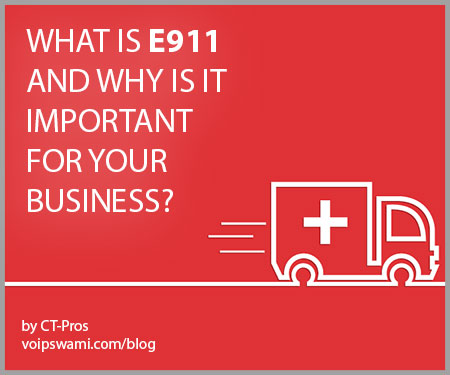
Swami Tech Talk Series
This post provided by Trish Cottone, Project Manager
Some background and insight into E911 and why it's important for your business.
In 1968, the U.S. Congress and the FCC agreed to support 911 as the emergency number standard for the nation. Since then a large majority of the country uses this service as well as Canada. All emergency calls for help are routed to 911 centers known as Public Safety Answering Points (PSAP).
The live agents at these PSAP's will obtain the callers exact location and call back telephone number in case they get disconnected. This can take valuable time in an emergency. If for some reason the call is disconnected, the PSAP dispatcher may not have the information needed to get help to the caller.
For this reason, Enhanced 911 or E911 was developed.
Enhanced 911 automatically transmits the customer address as well as phone number to emergency services when they dial 911. For businesses, the suite and floor number information can also be transmitted.
This enables the PSAP to dispatch emergency personnel to the scene even if the caller is unable to speak or the call is disconnected. You may have encountered a visit from the police when someone at your company accidentally dialed 911 and then hung up.
Who offers E911?
Traditional phone service providers offer E911 service on their products such as PRI, but a separate subscription to an outside 911 database provider would likely be required to implement and maintain the database.
All internet phone service providers interconnected with the PSTN, public switched telephone network, offer E911 as a standard to residential and business customers as well. These services include products such as SIP service. There are situations when E911 may not be available or limited using internet for voice.
VoIP service customers should be aware of other challenges. Because your VoIP phone can be connected virtually to any internet connection anywhere, this can create challenges determining the correct location from which a 911 call originated.
You may be working at home or a hotel, rather than in the office one day and have an emergency. End-users should be made aware of this risk and instructed to provide the dispatcher their exact address and location information when dialing 911 from their business phone or wireless phone.

Businesses using VoIP carrier services should also be aware of the following risks:
- VoIP calls to certain PSAP's may not automatically transmit the user's phone number or location due to a lack of proper equipment to display the information.
- VoIP customers will need to provide location information to their VoIP providers and update this information as it changes for the service to function properly
- In the event of a power failure, or internet connection failure, E911 service may not work. Consider installing a backup power supply or having a traditional phone line (POTS) or wireless phone available as a backup.
Considerations when implementing and maintaining your E911 service:
Customers are required to provide a list of all telephone number, address and suite and/or floor information to their carrier service provider or 3rd party database provider.
If that phone number moves to another office or floor, this information needs to be updated with your carrier for the service to work properly. Check with your PSTN or VoIP provider for instruction on maintaining and making changes to this information.
Traditional PRI providers will likely require you to subscribe to an outside service such as 911ETC or Intrado or RedSky to setup and maintain the PS-ALI (private switch-automatic location information) database.
Your carrier may provision your voice service to override your PBX programming and send one single telephone number for all 911 calls. This may work fine if all end-users reside at the same location, but not if they are spread throughout different offices.
Careful consideration should be made when designing and maintaining your E911 service.
Your PBX also plays a role in routing 911 calls. For example with MiVoice Connect, the system can use various methods to determine what information is sent to the PSAP.
- User defined Caller ID number along with User Group setting for CESID
- User defined DID number along with User Group setting for CESID
- Caller's Emergency Service ID (CESID) for a specific IP range
- CESID of the controlling switch
- CESID of the site
- If none of these are defined, the service provider will send the caller id number associated with the trunk, known as the billing telephone number or BTN.
Don't risk the safety of your end-users. Take the steps today to properly design and maintain a phone number database with your providers and vendors to ensure your employees get prompt attention when a crisis occurs.